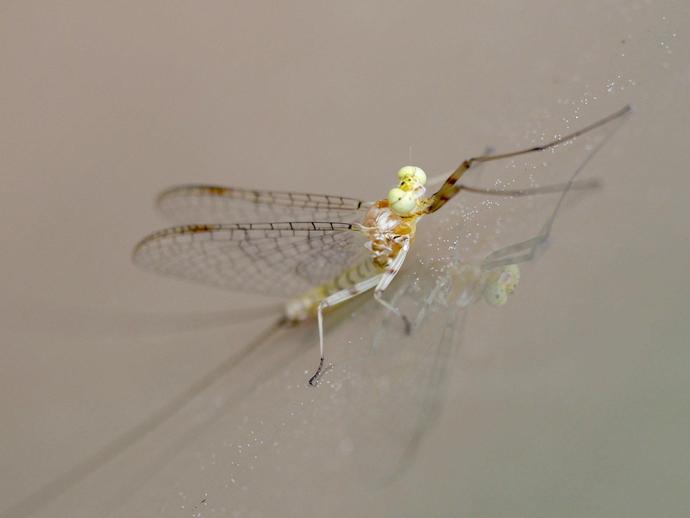April 28, 2021
It's time for the Wednesday edition of #BenInNature presented by our friends at Carter Bank & Trust!
Here's a nature post for VMNH Assistant Curator of Archaeology and Master Fly Fisherman Dr. Hayden Bassett: a mayfly!
This particular mayfly belongs to the family Heptageniidae, also known as the flatheaded mayflies, and it is most likely a member of the genus Epeorus, according to VMNH Executive Director Dr. Joe Keiper. There are more than 600 species just in the family Heptageniidae, and believe it or not, there are more than 3,350 known species of mayflies worldwide!
As juveniles, mayflies are completely aquatic. These juveniles are known as "naiads" or "nymphs," and if you find them in your stream, it means it's clean and unpolluted. They emerge from the water and molt into a pre-adult winged form known as the "subimago," and then molt again into a final winged adult form called the "imago." Mayflies are the only order (Ephemeroptera) of insects that have this winged pre-adult stage!
As I mentioned at the top, anyone with a keen interest in fishing is intimately familiar with mayflies. What makes mayflies popular with anglers is that different species tend to emerge in vast numbers at different times between spring and autumn, and fish go crazy for them when they emerge. Most mayflies only live about a day once they reach their adult form, and they spend that brief time attempting to mate and pass on their genes. A whole lot of mayflies end up tumbling back into the water during this period, and if an angler can hit that brief window with the right kind of fly, it results in a great day of fishing!
Of course, for non-anglers, mayflies can be a bit of a pest. In some areas, the mayflies emerge in such enormous numbers that they actually show up on weather radar -- and you can imagine what it's like when all those insects die within a day and start stinking up your town. The good news is, mayflies pose no threat to humans. They don't have stingers and they won't bite; in fact, some species literally can't bite, because the adults don't have mouths or digestive systems!
Thank you to Dr. Keiper for the ID on this specimen!
ABOUT #BenInNature
Social distancing can be difficult, but it presents a great opportunity to become reacquainted with nature. In this series of posts, Administrator of Science Ben Williams ventures outdoors to record a snapshot of the unique sights that can be found in the natural world. New updates are posted Monday - Friday, with previous posts highlighted on the weekends. This series of posts is made possible thanks to the support of VMNH Corporate Partner Carter Bank & Trust (www.cbtcares.com).
NATURE PHOTO IDENTIFICATIONS
If you discover something in nature that you would like help identifying, be sure to message us right here on Facebook with a picture (please include location and date of picture) and we'll have our experts help you identify it!

 Hours & Admissions
Hours & Admissions Directions
Directions

